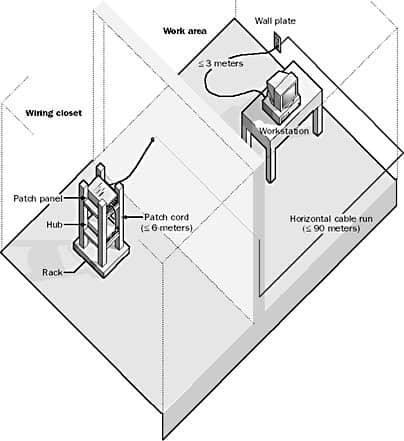Tutorial: Horizontal vs. Backbone Cabling: What’s The Difference?
by Madeline Miller
Introduction:
In creating a computer network, you’re going to need physical cables in place to deliver telecommunications services where they’re needed. As a business, you need to know how to set up that cabling system to get the best results. There are two main ways this can be done: either through backbone cabling, or horizontal cabling. What does this mean, and what’s the difference between the two?
What Is Backbone Cabling?
Backbone cabling can be referred to as vertical cabling. It is usually how you’ll connect the telecommunications room to entrance facilities, equipment rooms and so on. Typically, you’ll see that the cables will run from floor to floor of your building, but they can run on the same floor and be referred to as backbone cables still.
-
Backbone cabling can be divided further into inter-building and intra-building cablings.
-
Inter-building cabling is installed between two or more different buildings, intra-building cabling is done within one building.
The wiring for backbone cabling can be coaxial, twisted pair copper, or optical fiber. These days, optical fiber is the popular choice as it’s much faster, and so lends itself better to the longer lengths that need to be used in this kind of cabling.

What Is Horizontal Cabling?
Next, let’s take a look at horizontal cabling. Again, this cabling extends from the telecommunications room, but this time it goes out to individual work areas. Usually, this is done in a star shape topography. As such, the system will include cabling from the telecommunications room, an optional consolidation point, mechanical terminations, and patch cords or jumpers in the TC room itself.
There are other ways that that cabling can be put into place as well. The star topography is a popular method, but connecting everything in a ring topography also works in some situations, although as everything is connected through one cable if one point goes down, everything goes down.

The Differences Between Horizontal And Backbone Cabling
So what’s the difference between these types of cabling? While they sound quite similar, you’ll see that you’ll want to pick one or the other, depending on what you’d like to connect.
The biggest difference is in the areas that they cover. Backbone cabling will usually connect entrance facilities, equipment rooms, and so on in your building. Horizontal cabling, on the other hand, will cover individual work areas and outlets on the building’s floors.
You’ll also see that backbone cabling typically runs throughout the floors of the building, or even to different buildings as needed. Horizontal cabling, as the name implies, will usually be contained to one floor, the same floor as the telecommunications room. It is possible to run horizontal cabling between floors if needed, but it’s not recommended. Even if you do run it between floors, it still remains horizontal cabling rather than backbone cabling, as it’s still serving that particular function.
The two types of cabling also have different structural requirement, as they’re installed and used in different ways. For example, backbone cabling needs to be strong enough to support its own weight as it passes between floors. It also needs to be secured properly to ensure it’s safe and meets building codes.
Finally, you’ll see that backbone and horizontal cabling both have their own fire ratings and standards that they have to adhere to. These will be fairly simple when you’re dealing with horizontal cabling, but when it comes to backbone cabling there can be different rules, depending on how the cables are installed. For example, you may need to adhere to different codes if your cables go underground. In these cases, it’s always best to talk with a cabling contractor to see what you’ll need to do.
Picking The Right Type Of Cabling For Your Project
Now you know the differences between backbone and horizontal cabling, you’ll need to decide which one is right for the project you have in mind. The biggest thing you’ll have to consider is what exactly you’re looking to connect up. If it’s workstations that you need to get online, it’s going to be horizontal cabling that you need. If you’re looking to connect up other resources, then you’re more likely going to need backbone cabling.
As with most things, what you’ll need will vary from project to project. As such, you’ll want to look into it with a cabling expert. They can recommend the right set up for you, and ensure that it’s done to code and safely, too.
Conclusions:
Now you have all the basics about what backbone and horizontal cabling systems are, and which one will be the one you need for your building and needs. Now you know this, you can start planning your cabling with a certified installer, and get everything up and running. Wishing you success!
Biography:
Madeline Miller is a writer at Academized and UK Writings. Her expertise is is in telecommunications. She also blogs for State of Writing.
References:


